| |
| 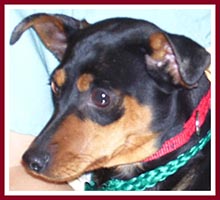 Except in some sad,
rare circumstance where they originally came from companion homes, most puppy
mill breeder dogs have never been treated as pets. They are considered
livestock -- the puppies, a cash crop -- and rescued mill dogs (and other
Survivors of abuse and neglect) are suffering, in a very real sense, from some
degree of post-traumatic stress disorder. Dr. Melinda Merck, in a November 2005
article for Critter Chatter, states: "Just like in humans, symptoms
of PTSD in animals can be triggered by visual cues, smells, sounds, or objects
associated with the trauma. Symptoms of PTSD that animals can exhibit include:
submissive urination or defecation; unusual or fearful reactions to certain
people, garments, hats, or other reminders of the trauma; shaking; flinching
when someone tries to pet their head; snapping at your hand; and some animals
can even seizure with extreme fear." Except in some sad,
rare circumstance where they originally came from companion homes, most puppy
mill breeder dogs have never been treated as pets. They are considered
livestock -- the puppies, a cash crop -- and rescued mill dogs (and other
Survivors of abuse and neglect) are suffering, in a very real sense, from some
degree of post-traumatic stress disorder. Dr. Melinda Merck, in a November 2005
article for Critter Chatter, states: "Just like in humans, symptoms
of PTSD in animals can be triggered by visual cues, smells, sounds, or objects
associated with the trauma. Symptoms of PTSD that animals can exhibit include:
submissive urination or defecation; unusual or fearful reactions to certain
people, garments, hats, or other reminders of the trauma; shaking; flinching
when someone tries to pet their head; snapping at your hand; and some animals
can even seizure with extreme fear."
The Survivors,
especially puppy mill survivors, have special problems and needs, depending on
their individual personalities and past experiences. Some respond fairly
quickly to love, steady meals, and a comfortable bed. Others require a great
deal of patience and guidance from someone experienced in rehabilitating mill
dogs; they can become wonderful family pets but may always have emotional scars
and "quirks." A few, unfortunately, are so traumatized that they may
learn to co-exist with humans but will never be "pets."
In October 2011,
Dr. Frank McMillan, under the auspices of Best Friends Animal Society, along
with Drs. James Serpell and Deborah Duffy at the University of Pennsylvania
School of Veterinary Medicine, released the findings of a landmark study of
dogs who are subjected to the isolation and deprivation of mass commercial
breeding conditions ("Mental health of dogs formerly used as 'breeding
stock' in commercial breeding establishments." FD McMillan, DL Duffy, JA
Serpell. Applied Animal Behaviour Science 2011; 135: 86-94.)
Dr. McMillan
summarizes: “This study gives us strong evidence that the dogs kept in
these large-scale breeding facilities don’t just suffer while they’re
confined there, but carry the emotional scars out with them for years, even
when they’re placed in loving homes.” His findings come as no
surprise, but this is the first study to identify the damaging effects of mill
life on canines, and may influence future laws regulating commercial breeding.
(See Best Friends Blog:
Puppy mills-USA Today reports on breakthrough study by Best
Friends Animal Society, and
Studies of Dogs From Puppy Mills, also from Best Friends
Animal Society. To obtain a copies of the complete studies, contact
puppymillinitiatives@bestfriends.org.)
Fostering or
adopting a Puppy Mill Survivor, or indeed a Survivor of any type of severe
trauma, requires a huge commitment of time, resources and self. These dogs are
not for everyone.
The information in this article is based on the experiences of
individuals and the observations of experts - but the authors don't even
pretend to be experts themselves or to know everything. Some rehabilitators
vehemently disagree with what works for others, and it can be very
confusing.
The best advice we
can give you is: Working with puppy mill and other
trauma survivors is an ongoing education. Each dog, each situation, is
different; you need to be flexible and creative in your responses to a
particular animal. The key in many cases is overcoming
fear and insecurity -- learn what particular factors trigger these in your dog,
and you're halfway there.
Rescuers of
abused/neglected dogs in the general animal welfare community will see
similarities to their own situations here, and many of the suggestions are
universal. We have included examples of how rescuers and adopters have dealt
with various problems with their Survivors. If you have a suggestion or
experience you would like to share, please feel free to
Contact us.
|
| |
 The Name Game: The Name Game:
 As for humans, part
of a dog's self-identity is tied to his name. Even if he hasn't heard it very
often, it's still Who He Is. The first act of many fosters or adopters is to
change that name, thinking to divorce the dog from his horrendous past. In some
cases, if the animal seems to be particularly fearful when called by his
"real" name, this may be necessary. However, in effect, immediately
changing a dog's name is taking away one more thing that is familiar and
comforting. As for humans, part
of a dog's self-identity is tied to his name. Even if he hasn't heard it very
often, it's still Who He Is. The first act of many fosters or adopters is to
change that name, thinking to divorce the dog from his horrendous past. In some
cases, if the animal seems to be particularly fearful when called by his
"real" name, this may be necessary. However, in effect, immediately
changing a dog's name is taking away one more thing that is familiar and
comforting.
I
had personal experience with this as a volunteer with an all-breed dog and cat
rescue. The rescue had taken in a Dalmatian from a neglect situation, and since
Dalmatians are my "breed," I was called in by his foster Mom when
there seemed to be a problem.
The foster
maintained that "Bear" was deaf because he wouldn't respond to his
name when called. I hadn't heard about any foster Dal named Bear, but I had
been told that a Chief had been rescued. So I asked, "You mean
Chief?" "No," I was told, "his name is Bear."
OK. Getting out
of sight of the dog, I called, "Hey, Chief!" Have you ever seen
a dog do a happy dance? He immediatly whirled to the sound of my voice, tail
madly whipping the air, tongue out in a joyful doggy grin, as if to say,
"At last, somebody knows who I am!"
The rescuer
hadn't liked the name Chief, so she'd arbitrarily changed it to Bear when
filling out the intake paperwork. Chief was lucky that I was informed about his
rescue before his name had been changed. Needless to say, the foster finally
knew how to get his attention.
If you do feel you
need to change a dog's name, please do it gradually, linking it, at first, with
his "real" name and, if possible, keeping some of the key sounds:
"Tessie-Bessie," "Chrissy-Susie," for example. After the
animal gets used to hearing the new name, the old one can gradually be dropped.
NOTE: Some mill
dogs have never even heard their names, so changes don't matter. It may take
these guys some time to get used to ANY name at all. Dogs who haven't been
spoken to except for commands (or curses) don't quite know how to react to
conversation at first. They may just stand there anxiously and wonder what you
want them to do -- or what you are going to do to them. Just keep talking to
them in a kind, patient tone. The more you talk to the animals, the more they
will understand!
|
| |
Top
|
| |
 "Pick Up" Lines: "Pick Up" Lines:
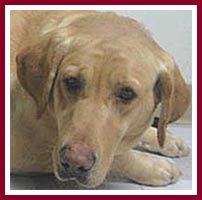 When we see an animal
hurting or afraid, our first instinct is to swoop him up and hug him. With mill
and trauma survivors, as with any unfamiliar animal, this isn't a great idea.
Remember, what little physical contact mill dogs receive is likely unpleasant,
if not downright painful. They are often jerked from their cages by the scruff
of their necks or by one leg for vetting, breeding -- or to be shown off on the
auction block. If the dogs resist, bark, or struggle, they are likely to be
smacked across the face or, if they are in a pen, kicked. It's only common
sense that these dogs are going to be scared of hands coming toward them.
Two-year-old Precious Lady, pictured here, challenged rescuers after her
purchase at the 10 March 07 Thorp dog auction because she was terrified of both
hands and feet coming near her. (You can read more about her on her
Scrapbook
page.) When we see an animal
hurting or afraid, our first instinct is to swoop him up and hug him. With mill
and trauma survivors, as with any unfamiliar animal, this isn't a great idea.
Remember, what little physical contact mill dogs receive is likely unpleasant,
if not downright painful. They are often jerked from their cages by the scruff
of their necks or by one leg for vetting, breeding -- or to be shown off on the
auction block. If the dogs resist, bark, or struggle, they are likely to be
smacked across the face or, if they are in a pen, kicked. It's only common
sense that these dogs are going to be scared of hands coming toward them.
Two-year-old Precious Lady, pictured here, challenged rescuers after her
purchase at the 10 March 07 Thorp dog auction because she was terrified of both
hands and feet coming near her. (You can read more about her on her
Scrapbook
page.)
To a dog, being
grabbed and picked up is also a "dominance" thing. It leaves him
feeling powerless and afraid. Look at it this way: how do YOU like being
grabbed and swept off your feet by a total stranger?
Most mill dogs
have long since had their spirits broken and any aggressiveness toward humans
knocked out of them. A very few, like Dalton (pictured in the next section),
will react to any attempts to touch them by totally "freaking out"
and trying to bite the hand that threatens them. More heartbreaking are those
who just "freeze" and passively -- miserably -- seem to say, "Do
what you will with me." Some may drop to their bellies and grovel, or do
the "submissive roll" over onto their backs. Some may urinate out of
fear or submission -- and this isn't at all the same thing as a
"housebreaking" problem. In this case, he is saying, "You're the
boss; I'll do anything you say -- just don't hurt me!"
What should you
do? Easy -- unless you absolutely have to pick the dog up, don't! Take the time
to earn his trust. And never, ever reprimand or punish him for that submissive
"peepee."
See
Trust Me; I Know What I'm Doing, below, for tips on
accustoming your mill dog to your touch, and Marking/Submissive/Excitement Urination to learn more about
how to desensitize your dogs to situations that bring on submissive behavior.
|
| |
Top
|
| |
 Trust Me; I Know What I'm Doing: Trust Me; I Know What I'm Doing:
 You
know that your mill dog/ trauma survivor's life has changed forever, for the
better. He, however, doesn't know it. Up to this point, his
existence hasn't exactly been filled with kind and loving gestures. The scenery
has changed, granted, but that just means he's in unfamilar territory without a
clue what is coming next. You
know that your mill dog/ trauma survivor's life has changed forever, for the
better. He, however, doesn't know it. Up to this point, his
existence hasn't exactly been filled with kind and loving gestures. The scenery
has changed, granted, but that just means he's in unfamilar territory without a
clue what is coming next.
He may, like
Dalton, here, be so fearful of touch that he won't even allow an ear scratch or
a chin chuck, let alone a "99 years to stop" massage that many people
take for granted with a pet. He may not take a treat from a human hand, or even
eat when a human is present. He may freeze, cower, tremble, or position himself
with his back to the wall, so to speak, so that you can't come up behind him
and do something terrible.
In a nutshell, you
will have to earn his trust. Again, with some dogs, this is easy. With others,
it may take more patience than you ever realized you had.
Accustoming the
dog to your touch is the first step. Sooner or later, you're going to have to
handle him -- to take him to the vet, to care for "owies," whatever.
And he certainly needs to learn how to enjoy a good petting! So -- let the dog
find a spot where he feels safe and comfortable, then sit next to him and talk
to him. Let him get used to you gradually. Tell him he's a good dog, a
beautiful dog, recite poetry or make up a silly song -- just use his name a lot
and lull him with your voice. Edge closer; reach carefully but not tentatively,
touch confidently. Work with him over several short sessions if necessary.
He'll eventually learn to accept your touch, then, gradually, to enjoy it.
(Note: in rare cases, a dog may never accept human touch, but -- Don't ever
give up trying. None of the articles we've come across in our research have
been able to define "never.")
Dalton, now called
DJ, was so terrified of people when he was purchased by a rescue at the 10
March 07 Thorp dog auction that he was listed as a rare mill rescue "fear
biter." Says his foster mom, who is experienced with dogs with
"issues":
"The first
three times I tried to touch him, he proceeded to go crazy and try to eat me. .
. . about eight hours [and several short sessions] later, he finally stayed
still, didn’t attempt to bite and let me touch him. From there on he made
no more attempts to bite. He is progressing well, loves the pack walk each
morning with my dogs (anywhere from 4-6 dogs). He gets a massage each day by
myself or my husband; touch is coming easier but he still would rather not have
it.
"I know he behaves the
way he does because of no confidence; hence I don’t want to coddle the
behavior he is exhibiting. The massage is deep and somewhat firm, not soft like
being petted. I want to touch him like another dog would.
"...The cringing he
did initially was pitiful. His skin still crawls slightly when you start but he
relaxes eventually. He needs my confidence to relax; the firm touch seems to
let him know I‘ve got everything covered -- I’m in control."
(To read more, please
click here.)
When you do
approach the dog to touch, don't immediately reach for his head or his face. Or
the back of his neck, for that matter. You have to play it by ear (so to
speak). Some face-shy dogs must be approached from the side and not straight on
before they will allow their necks or under their jaws or their cheeks to be
touched. Some will allow you to stroke their backs but not their heads. Watch
your dog's body language, and respect his wishes as much as you can. As he
learns to trust you, he'll allow more "liberties."
When the dog is
relatively comfortable with your touch, start working on picking him up. Don't
swoop, or make any fast moves toward him; don't grab him from behind. Be
matter-of-fact about it; let him know you're going to lift him, then do it. Use
a single word or short phrase consistently to signal your intention, because
though he may have grown to like the sound of your voice, his actual
understanding of vocabulary is still very limited. Keep it simple so that he
can associate the word(s) with the act of being lifted securely but kindly,
without pain.
Some experts
advocate using treats for accustoming the dog to your touch and gaining his
trust. However, some mill dogs won't take anything, not even a treat, out of a
person's hand. It may be a "chicken - egg" situation: which will he
accept first, the treat or the touch?
|
| |
Top
|
| |
 Home, Sweet Home: Home, Sweet Home:
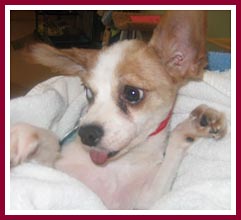 For an animal who has
spent his entire life in the confines of a cramped cage or a pen, a House is a
strange, wonderful -- and frightening -- place. It's huge, it smells funny (to
noses used to feces, urine, and other filthy dog bodies), and it's filled with
scary things, noises, and people. Remember, your mill dog has probably never
seen a flashing, talking box (TV); faced a set of stairs, or heard a vacuum
cleaner whoosh on. Even your coming toward him with a tissue in your hand may
send him into a blind panic. For an animal who has
spent his entire life in the confines of a cramped cage or a pen, a House is a
strange, wonderful -- and frightening -- place. It's huge, it smells funny (to
noses used to feces, urine, and other filthy dog bodies), and it's filled with
scary things, noises, and people. Remember, your mill dog has probably never
seen a flashing, talking box (TV); faced a set of stairs, or heard a vacuum
cleaner whoosh on. Even your coming toward him with a tissue in your hand may
send him into a blind panic.
Everything is new;
everything is a potential threat. Your Survivor may just want to dig himself
into a quiet corner and hide. This is not a good time to invite all of your
friends and relatives over to meet him. In fact, you might want to confine him
to a quiet area for a period of adjustment, and observe him to get a handle on
what will trigger his fears.
Having at least
one friendly, secure dog already in the household can be a huge advantage when
you bring your Survivor home. Obviously, you're going to introduce them
carefully, particularly if your Survivor has been, say, a bait dog for a dog
fighting ring. However, aside from the basic security of providing another pack
member of the same species ("Wow, someone who speaks my language!"),
the resident dog or dogs likely will help show the newcomer the ropes. He/they
will teach, by example, where the best blades of grass to water are, when to
ask to go out, and that People are the Givers of Good Things. Just seeing the
interaction between you and the animals already in your household may give the
newcomer a sense of security -- hey, you're not hitting, kicking, or yelling at
them and they like to have you touch them. Maybe it's going to be OK here after
all.
Crates create a
safe "den" for your Survivor. Some people think of crates as
"cruel," but for most dogs who have lived in a cage all their lives,
their crates, with the doors always open, are a safe haven where they can
escape from the scary world, get some quiet time for themselves -- or even
enjoy treats and toys securely. As Dalton's foster mom tells us, "Most
of his day is spent kenneled, not because the door is closed (it’s not)
but because that’s where he is most comfortable." The crate
should be in a central location, where his back can be to a wall but where he
can also be part of the daily activity. (Check your favorite internet search
engine for tips on "crate training.")
In the Thorp
Scrapbook photos and Josie's Diary, you will note that many of the dogs are
wearing light leashes indoors, even though they are cuddled on a couch or
hiding in a run. This serves a number of purposes. Leashes are likely another
new experience for your mill dog and may not be an altogether welcome one.
Clipping on a light leash around the house, when he will be supervised so that
it doesn't become caught on anything, will accustom him to this new piece of
fashion wear. It can also help you with training, as illustrated by this
excerpt from Josie's Diary:
At first, when I got her, I had to leave the
leash on her when she went outside as I was unable to get her to come to me and
I didn't want to chase and scare her. I would usually have to call Toby &
Tucker over to me, then she would follow them and I could get close enough to
her to step on the leash, then softly talk my way up to her, pick her up and
bring her in the house.
|
| |
Top
|
| |
 Chow Down! Chow Down!
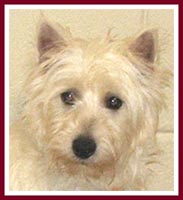 Even something as
basic as feeding your Survivor can be a traumatic experience. Remember, he's
been living in a confined space, probably eating low-quality and possibly even
spoiled food, maybe out of a pan shared with other dogs, maybe out of a
self-feeder. High-quality food out of a clean bowl set on the floor with you
hanging around to watch him eat may be an entirely new experience to him, and
one he's not sure what to make of. Even something as
basic as feeding your Survivor can be a traumatic experience. Remember, he's
been living in a confined space, probably eating low-quality and possibly even
spoiled food, maybe out of a pan shared with other dogs, maybe out of a
self-feeder. High-quality food out of a clean bowl set on the floor with you
hanging around to watch him eat may be an entirely new experience to him, and
one he's not sure what to make of.
First of all, he
previously may have had to fight with cagemates for every mouthful, so he may
show some food aggression himself. Conversely, he may refuse to eat at all when
other dogs or even you are in the room because he has been conditioned by
experience to eat only what the dominant dogs have left. If he exhibits either
of these tendencies, obviously you're going to want to feed him separately from
your other dogs until his "issues" are resolved.
Because knowing
that his food is coming from you at regular intervals will give him confidence
and some sense of security, you do need to try to get him on a regular feeding
schedule. These regular meals will also help with housebreaking. Don't leave
food down all the time. Do put the bowl down and at least stay in the room with
him for a certain period; if he doesn't eat, pick the bowl back up again. If he
doesn't eat or only nibbles at his food for the first day or so, don't panic.
He may just be acclimating himself to his new environment, and his tummy may be
a bit upset.
If, however, after
a few days your dog still isn't eating, you may have to try more creative
measures. It was literally months before Christy/Josie, pictured above, would
eat or drink out of a bowl. Her foster mom told us that even three months after
Christy's purchase at the Thorp Dog Auction:
We
are ... struggling to get her to eat or drink. She will only drink when we are
not at home and she is in her crate. She sometimes will take a couple of
panicked bites of food in her crate but I have had the best luck hand feeding
her. She seems afraid of bowls, plates, etc. She ignores food that I leave on
the floor of her crate. She loves treats now, too, but the only way I can get
her to eat more than a couple bites is to hand feed her when she is in her
"safe" recliner. Please read more about Christy/Josie's progress
in Josie's Diary
An elevated bowl
may help a mill survivor feel more at home at mealtime, too. These can be
purchased from any pet supply store, or a home-made box with a bowl-sized hole
cut into it can be constructed from scrap lumber or particle board. And, in
some cases, the only way a mill survivor will drink at first is from a
"rabbit bottle" clipped to the side of his crate -- because this is
what he's used to.
|
| |
Top
|
| |
 The Art of Escape: The Art of Escape:
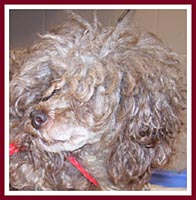 Ogden Nash is
credited with saying, "A door is what a dog is perpetually on the wrong
side of." Anyone who has ever lived with a dog knows just how true this
is. Canines are naturally curious creatures at the best of times -- a door
opens, and they're going to want to get to the other side. It's just common
sense to remind family members to be very careful going in and out so that your
new mill survivor doesn't slip past and get outside unsupervised. Ogden Nash is
credited with saying, "A door is what a dog is perpetually on the wrong
side of." Anyone who has ever lived with a dog knows just how true this
is. Canines are naturally curious creatures at the best of times -- a door
opens, and they're going to want to get to the other side. It's just common
sense to remind family members to be very careful going in and out so that your
new mill survivor doesn't slip past and get outside unsupervised.
However, there is
also the possibility of your Survivor suddenly and unexpectedly suffering a
panic attack from any of the new, strange, and scary things inside your home,
and his instinct will be to flee. He may race directly to his crate or
"safe place," but he also may scoot out any door that is ajar, claw
through a window screen, or, in rare, extreme cases, hurl himself through plate
glass.
Even if he is in
his own secure backyard, the sound of thunder, a firecracker, a car with a loud
muffler or stereo, a neighbor child on a skateboard, or something as innocuous
as a large bird shadow, can send him into blind, frantic flight. He might go
over a fence, under a fence, through a fence, or even disappear under a deck or
storage unit when your back is turned. And once he gets there, chances are he's
going to be too scared to come to you even if he wants to.
Vigilance is the
key -- get down on dog level and try to see your home and yard form his
perspective. Block off obvious escape routes; imaginatively-placed baby gates
can add one more level of security inside the home. Outside, be sure to block
off anyplace that your dog can go under a fence, triple-check that the fence is
secure all around and the gate latches properly, and remove anything the dog
may be able to jump up on to go over the fence.
Then, when your
Survivor is outside, SUPERVISE him constantly for the first few weeks (if the
dog shows any inclination to seek out escape routes, even longer).
Accidents happen,
and dogs do get out of their homes and yards. If your Survivor becomes lost,
don't panic. He needs you to be calm and methodical about getting him back.
Tell anyone you have helping you search also to be calm, call the dog's name
confidently and in a "happy" voice, and don't try to approach the dog
him/herself.
Studies show that
timid dogs do not wander far from their homes. They will seek shelter under
bushes, shrubs or porches; so when you are searching for them, look close and
look low. Be imaginative. One mill dog escaped her foster home and was found
days later within two blocks, holed up in a clump of shrubbery. Her foster mom
had probably walked past her a dozen times. She was glimpsed snatching up food
that a neighbor left out for her, but she would not allow anyone to approach
her -- not even her foster mom.
This is typical:
no matter how much the escapee likes and trusts you, chances are, he will be
too afraid to come to you. Sometimes, he'll allow himself to be drawn out of
hiding by a canine friend; sometimes, he'll come to food or treats. Sometimes,
a livetrap borrowed from a shelter or rescue will be the only way to recapture
him. Just remember when trying to convince your escapee to come to you to be
calm and confident. He needs you, the pack leader, to project strength and
security.
Dogs DO pick up on
our emotions, but those animals who haven't lived with people don't know how to
intrepret those emotions. He may think your worry is anger directed at him; by
the same token, your "calm" might also be contagious. Remember how
you had to sit by him and talk to convince him to allow you to touch him? Try
it again, only with a trail of treats leading from his hiding place (or as
close as you can get without spooking him any more) to you. When he does come
to you, let him know what a good dog he is! Never, NEVER scold him for running
away!
A search on any
search engine on the key words "finding lost pets" will bring up a
wealth of resources. Also, check social media such as Facebook for Lost Dog
groups in your own area. And it goes without saying that you always, always
keep your microchip information and dog licenses up to date.
|
| |
Top
|
| |
 "To Pee or Not to Pee:" "To Pee or Not to Pee:"
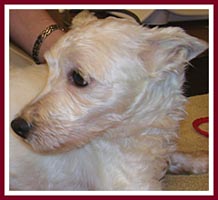 Before we go any
further, please note that there are three instances that most experts agree do
not relate to housebreaking at all: submissive/excitive urination, marking, and
coprophagia or stool-eating. These will be discussed in the next section. Before we go any
further, please note that there are three instances that most experts agree do
not relate to housebreaking at all: submissive/excitive urination, marking, and
coprophagia or stool-eating. These will be discussed in the next section.
"Housebreaking
problems" aren't unique to mill dogs -- they're one of the top reasons
given for owner surrenders of animals to animal shelters -- but mill survivors
do have some unique "hang-ups" when it comes to house training.
Most dogs have an
inherant, instinctive aversion to soiling their living areas. The major problem
in housetraining most dogs is in defining "living area." Conversely,
however, a puppy mill dog who seldom or ever is taken from his cage has no
choice but to soil his living area. This living area is cleaned only
infrequently; sometimes only when feces and urine fall through the wire mesh of
the cage. In fact, it's not unusual for mill dogs to suffer foot injuries
caused or worsened by walking in their own waste. Whitey, the dog pictured
here, was one of several Thorp auction dogs purchased with sores on their feet
from urine burns. (Read more about Whitey on his
Scrapbook
page.)
So, while many
dogs are helped by instinct in housetraining, a mill survivor is hindered by
his conditioning -- both because he has spent a lifetime "going" in
his cage and because he probably has never walked on grass or spent a lot of
time free of constraints and thus also has those fears to conquer.
Remember that the
first few days may be difficult; in addition to the period of adjustment to a
foreign (to him) environment, he will also be adjusting to new food, clean
water, treats, possibly medications, noise, humans, etc. These may result in
tummy aches, frequent urination, and "the runs."
The key, once
again, is PATIENCE. A regular feeding schedule, constant reinforcement and
praise, and vigilance on your part are crucial. If the dog is on a regular
feeding schedule, it stands to reason that he'll be on a regular potty
schedule. Put him out frequently -- if you have other dogs, they'll help him
get the idea of what he's supposed to do, and when he does it, let him know how
wonderful he is! When he is outside, watch him. Most dogs have a
"ritual" that they perform just before they "go" -- some
sniff, some dance, some circle. Understanding his "tell" will also
help curb accidents in the house. When you see him performing these behaviors
inside, get him outside quickly before he has a chance to fail!
By the way, there
are many products available in your pet supply store for cleaning up
"accidents" in the house. Just remember, you want to use something
that will mask the smell so that the dog doesn't think it's OK to
"go" there again. Cleaning products with ammonia aren't a good
choice, since ammonia is one of the components of urine (in fact, the component
that burns the paws). Many people use vinegar, but a product formulated just
for the purpose of cleaning up after pets may be your best bet.
Be cautious about
cleaning the floor with the dog watching - dogs can make some weird
associations sometimes. We know of at least one dog who thought that the smell
of the cleaning product marked a good target for pottying!
Some dogs need
more creative methods to teach them where they may "go." A rescuer
told us that because her puppy mill/pet store survivor had never, ever been
outside, he wouldn't "go" unless he had the wire mesh that he was
accustomed to under his feet. So, she bought some wire mesh from a hardware
store and made a frame, then blocked it up a few inches off the ground in her
backyard. As the pup learned to use this as his "good spot," she
lowered it by increments, over the space of several days, down to ground level
so that he learned not to fear the feel of grass under his feet. Finally, the
mesh frame was removed, and the dog had a "good spot" that he used
for the rest of his life.
As we've said
before, every dog is different. Some will take to housetraining right away, and
some may take months. If the dog consistently "goes" in the house,
has loose stool or off-color or unusually stinky urine, check with your vet to
be sure thre isn't some sort of physical difficulty that is interfering with
housetraining -- a urinary or GI infection, bladder stones, a digestive enzyme
deficiency, etc. Be patient, be consistent, be vigilant, be enthusiastic, and
never give up trying.
|
| |
Top
|
| |
 Submissive or Excitive Urination/Marking: Submissive or Excitive Urination/Marking:
 Submissive
Urination: One of the ways a dog shows his submission to the pack
leader is to cower in front of him and urinate in tiny squirts. As mentioned
above, this has absolutely no relation at all to general housetraining, and
should not be punished as a housetraining accident. Since it is a way of
showing you that he knows you're boss, punishing will just result in more
submissive urination and a really scared, confused dog. Again, patience is the
key. As your dog becomes more confident, this behavior will lessen. Until then,
learn what triggers the behavior and try to avoid it. Submissive
Urination: One of the ways a dog shows his submission to the pack
leader is to cower in front of him and urinate in tiny squirts. As mentioned
above, this has absolutely no relation at all to general housetraining, and
should not be punished as a housetraining accident. Since it is a way of
showing you that he knows you're boss, punishing will just result in more
submissive urination and a really scared, confused dog. Again, patience is the
key. As your dog becomes more confident, this behavior will lessen. Until then,
learn what triggers the behavior and try to avoid it.
Excitive urination
is just that: the dog "widdles" when excited. There are many good
articles available with advice on how to desensitize your dog to situations
that bring on submissive behavior or excitive urination. A search on
"submissive urination" will yield a wealth of other web pages on the
subject.
Marking
is another left-over from pack behavior; dominant dogs mark their
territory with urine to alert other dogs to stay away. We laugh about our dogs
reading their "pee mail" when we have them out walking on a leash,
but when it happens in the house, it's no laughing matter. A dog who has never
been in a house doesn't realize that marking his territory is a "no
no." Taking him outside won't help, since it isn't about going potty. What
you need to do is let him know that it is NOT acceptable to mark in the house.
(By the way, marking can also be seen in females.)
Because marking
is generally a dominant behavior, correcting with a sharp "NO!" when
you catch the dog in the act should ultimately be effective as the dog
recognizes you as the pack leader. If this doesn't work, some sources suggest
keeping the dog on a light leash in the house and giving it a pop, with a sharp
"NO!" or "OFF!" every time he lifts his leg in the house.
Some experts suggest taking the dog for walks to places where he can safely
mark -- trees, fire hydrants, sign posts, etc. (NOT your neighbor's shrubs or
flower garden, please!).
If he has favorite
spots indoors to mark, distract him by placing treats around the spot to make
it a source of goodies rather than a trigger for marking. Or, make the spot
unpleasant by putting double-sided tape or a plastic carpet runner knobby-side
up on the area. Be creative - in one instance, spraying the spot with one of
the "no chew" preparations did the trick, as the dog associated the
smell with the bitter taste and stayed away! (Check the label to be sure you
can safely use the product on furniture or carpeting and test a small area for
staining first, though.)
Marking may be
the result of a rivalry between your Survivor and other dogs in the household
-- so some "conflict resolution" may be necessary there. This
behavior can be corrected, but, like everything else, it takes consistency and
patience.
Meanwhile, clean
his markings in the house throughly as you would for housetraining accidents,
with vinegar or with a product formulated for neutralizing pet urine odors. You
might also consider a "belly band" for him to wear until you can
convince him to stop trying to mark in the house. As the sex hormones decrease
in the two months after spaying or neutering, the incidence of marking may also
decrease and disappear on its own.
For additional
information on urine marking, please do a search on keywords "urine
marking." Some of the articles you find may seem to be contradictory. As
you get to know your dog, you'll learn which advice will or won't work for your
situation and philosophy. For extreme cases, when behavior modification alone
won't work, you might want to speak with your vet about trying a drug such as
Amitriptyline along with it (then back the dog off the drug again a month or so
after the problem is solved or the habit is broken).
|
| |
Top
|
| |
 Coprophagia (Stool Eating): Coprophagia (Stool Eating):
 Put simply,
coprophagia is stool ("poop") eating. While totally grossing out
human caretakers, dogs of all breeds, ages and sizes do it. To them, it isn't
abnormal or "icky" at all, and not generally harmful, though
intestinal worms and some diseases are passed along through the stool. As in
any bad habit, the cure lies in understanding the unacceptable behavior. Put simply,
coprophagia is stool ("poop") eating. While totally grossing out
human caretakers, dogs of all breeds, ages and sizes do it. To them, it isn't
abnormal or "icky" at all, and not generally harmful, though
intestinal worms and some diseases are passed along through the stool. As in
any bad habit, the cure lies in understanding the unacceptable behavior.
There appear to
be several reasons that dogs in general, and puppy mill dogs in particular, eat
stool. Among them:
They may have a physical problem, such as a digestive
enzyme deficiency, that allows most of the nutrients of the food to pass right
through the body without absorption. A vet can help determine if this is the
case; there are usually additional symptoms such as diarrhea.
The food they are getting does not have the nutritional
value and they eat their stool to make up for this or, they are hungry and
should be fed more frequently throughout the day.
Conversely, overfeeding the dog may result in more
undigested food being eliminated.
Mama dogs naturally eat their pups' stool in the
"clean-up" process -- to keep the "den" clean and also to
remove the scent that might attract predators.
Though repugnant to humans, the smell and taste of the
feces might just be a yummy treat to the dog.
In some cases, dogs have been known to eat feces out of
boredom or to get more attention.
Regardless of why
they do it in the first place, after a while it becomes habit. So. First, make
sure that there are no physical problems for which feces-eating would be a
symptom. Then, break the habit.
There are many
different suggestions out there, from training the dog to come immediately
after defecating and then giving him a treat reward to going around after the
dog and sprinkling hot pepper on the pile so that when he eats it, he'll get an
unpleasant shock. Some sources suggest mixing the meat tenderizer
"Accent" in the dog's food to make the stool taste bad, and there are
products on the market that you can use that also make the stool taste bad to
the dog. However, cleaning up immediately after your dog makes a
"deposit" and keeping the yard "poop-free" is the BEST,
first step in breaking this habit! It's a royal pain in the neck, but
with some dogs, it's the only solution.
An excellent
article, "How to Deal with a Dog Who Eats Poop", can be found on
The Whole Dog Journal website.
Click here for article.
Many experts agree
that, most of the time, if you can keep a dog from engaging in a learned
behavior (habit) for two weeks to a month, the habit will be broken. Of course,
that doesn't mean he won't pick it up again (so to speak) in the future.
Coprophagia is
considered a form of "pica," which is an unnatural need to eat
foreign objects. Most dogs will "experiment" with chewing rocks,
sticks, pine cones, etc., but a dog suffering from Pica will compulsively eat
non-food items. This may be a sign of a zinc or iron deficiency or some
underlying disease, or it may be psychological. If your dog seems to be
compulsive about eating undigestible items, see your vet immediately to find
out why he is doing it. A behaviorist can also help you figure out how to stop
this potentially dangerous behavior. Your dog's eating socks, pantyhose, and
your couch pillows is not just undesirable, it can be fatal if it causes an
intestinal blockage!
Tao, the shar pei
pictured at the beginning of this section, suffered from pica as a result of
severe malnutrition. His vet records indicate that, when rescued,his feces were
more than 50% hay the first three days after purchase. Read more about Tao on
his
Scrapbook
page.
|
| |
Top
|
| |
 Making New Friends: Making New Friends:
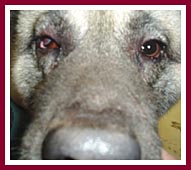 We've discussed
trying to make your Survivor feel at home, how to accustom him to your touch,
etc. However, in all probability, it won't be just you and your dogs in the
home -- you may have a spouse, housemate, children, or others living there.
Plus, visitors, your kids' classmates, and relatives will be dropping by; and
he'll have to get used to your neighbors, etc. We've discussed
trying to make your Survivor feel at home, how to accustom him to your touch,
etc. However, in all probability, it won't be just you and your dogs in the
home -- you may have a spouse, housemate, children, or others living there.
Plus, visitors, your kids' classmates, and relatives will be dropping by; and
he'll have to get used to your neighbors, etc.
Those in your home
will already have been "briefed" on how to cope with the new dog;
they'll realize they are not to sneak up on him, make loud noises, approach him
too quickly, wake him suddenly, or grab at him, but before friends or relatives
arrive at your door, tell them how to approach your Survivor, too. Let visitors
meet him one at a time so that he isn't overwhelmed; arm them with treats and
make sure they understand they should always let the dog come to them, and not
back him into a corner or chase him. If you notice your dog becoming tense or
frightened, signal the visitor to retreat. If guests include small children, or
if you don't think your mill dog is up to "company," put him in his
crate in a quiet place, with soft music or a favorite TV show, his coziest toys
and a treat or two. Don't ever force the dog to socialize if he doesn't want
to.
It is also a good
idea to speak with your neighbors about your Survivor. Ask neighbor children
not to poke their hands through the fence to try to pet the new dog, or yell or
chase him. Remind them that if a ball or toy comes over the fence, to ask you
to get it for them and not to climb the fence and come into your yard. Let them
know that they should ask first before tossing scraps from their backyard
picnic or bones from Sunday's roast over to him. If your dog is very sensitive
to loud noises, you might also ask your neighbors to let you know when they are
going to mow their lawns, blow leaves, or use some other noisy equipment that
may frighten your mill survivor, so you can be sure he is safely inside.
Emphasize that if they ever see the dog outside his yard alone, they should
inform you immediately!
Also, don't forget
you'll be introducing your Survivor to neighbor pets he might be sharing a
fence with, particularly if it's chain link.
PLEASE NOTE: If your foster is a survivor of a dog fighting
situation, please be very, very careful introducing him to new people and pets!
You may want to consult an animal behavior specialist or a rescue with
experience with this type of past trauma before proceeding.
|
| |
Top
|
| |
 In Summary: In Summary:
 Fosters and adopters
of puppy mill/trauma survivors face many other challenges and dilemmas:
physical problems, separation anxiety, over-protectiveness, etc. on the part of
the dogs, and unforeseen difficulties such as sleep deprivation (because he
keeps getting you up several times a night to potty or just to reassure himself
that you are there) for you. As you have probably figured out, a Survivor may
also be a huge drain on your time and energy. Fosters and adopters
of puppy mill/trauma survivors face many other challenges and dilemmas:
physical problems, separation anxiety, over-protectiveness, etc. on the part of
the dogs, and unforeseen difficulties such as sleep deprivation (because he
keeps getting you up several times a night to potty or just to reassure himself
that you are there) for you. As you have probably figured out, a Survivor may
also be a huge drain on your time and energy.
And, occasionally,
fosters will run into a really hard-luck case who is so "shut down"
that he seems impossible to reach. He may have been so traumatized that he will
never trust anyone. When do you give up trying? Never. Accept each dog for who
and what he is, certainly, but never give up hope that he will someday discover
some of the simple joys "normal" dogs take for granted. He may be a
permanent foster, or you may find the perfect home with someone who understands
his needs and already has a canine pack for him to "lose" himself in.
Lazarus, bought at the 10 March Thorp dog auction, may be one of those
hard-luck cases, though after only five months, it is still too soon to tell.
For Lazarus's story, please see his
Scrapbook
page.
When you look at
your Survivor, look forward to the wonderful life he will have and not back at
the horrors from which he came. And, tough as it may be, don't be
over-protective of him. Nurture and encourage him. Watch him and learn his
fears, his hang-ups, then set up situations where he can explore, experience
success, and build his self-confidence. Remember: as with any dog, it is much
better to head off non-approved behavior before it occurs, than to try to
correct him after he does something wrong.
Fostering or
adopting a puppy mill/trauma survivor is not for everyone, but, as one
experienced foster tells us, "It is an experience beyond words."
|
| |
Top
|
| |
 References/Resources: References/Resources:
Here are some of
the resources that we used to put together this article. Unfortunately, many of
the sites we used for reference are no longer available. However, a search, on
any search engine, using keywords such as "housetraining pets" or
"submissive urniation" will find you information to study. Just be
careful to stick with trusted sources such as national organizations, vet
schools, and experienced rescues that can back what they say.
If you have a
favorite web resource or know of a helpful email list or online forum, please
Contact us so that we can
share it.
- Rehabilitation of a Puppy Mill Dog, by Michelle Bender and
Kim Townsend
- Post Traumatic Stress Disorder (PDSD) in pets:
- A landmark study of dogs who are subjected to the isolation and deprivation
of mass commercial breeding conditions conducted by .Dr. Frank McMillan, under
the auspices of Best Friends Animal Society:
- To obtain a copy of "Mental health of dogs formerly used as 'breeding
stock' in commercial breeding establishments." FD McMillan, DL Duffy, JA
Serpell. Applied Animal Behaviour Science 2011; 135: 86-94., contact
puppymillinitiatives@bestfriends.org.
- Best Friends Blog:
Puppy mills-USA Today reports on breakthrough study by Best
Friends Animal Society,
- Best Friends:
Studies of Dogs From Puppy Mills: a summary of "Mental
Health of Dogs..." mentioned above and also of "Differences in
behavioral characteristics between dogs obtained as puppies from pet stores and
those obtained from noncommercial breeders." FD McMillan, JA Serpell, DL
Duffy, E Masaoud, IR Dohoo. Journal of the American Veterinary Medical
Association2013; 242: 1359-1363.
- USA Today: Puppy mills leave lasting emotional scars, study finds
- PR Web: New Study Shows Dogs in Puppy Mills Suffer Long-lasting, Severe
Psychological Harm
- Mental Health of Puppy Mill Dogs
- PAW Rescue: Emotions in Canines and in Humans
- General -- these websites offer dozens and dozens of article links on all
topics:
- Finding Lost Pets:
- A search on any search engine on the key words "finding lost
pets" will bring up a wealth of resources. Also, check social media such
as Facebook for Lost Dog groups in your own area.
- ASPCA Tips on Finding A Lost Pet
- Submissive/Excitive Urination:
- Ahimsa Rescue Foundation article on submissive urination
- Urine Marking:
- ASPCA article on Urine Marking
- The Pet Place: Urine Marking
- Coprophagia (stool eating) and Pica:
- Canine Concepts, UK: Why Does My Dog Eat Stools?
- ASPCA article on Coprophagia (Stool Eating)
- Introducing a New Dog to other pets:
- ASPCA article on introducing dogs
|
| |
Top
|
| |
|
 Printer Friendly
Version Printer Friendly
Version  Acrobat Reader Acrobat Reader
 Josie's Diary Josie's Diary  Don't Buy The Lies: the Thorp Dog
Auction, 10 Mar 07 Don't Buy The Lies: the Thorp Dog
Auction, 10 Mar 07  Contact
us Contact
us 
|
| |
|
| |
|
Home * Contact
Us * Site Map
What is a Puppy
Mill? * What YOU Can Do * Laws/Legislation * Action Alerts
Thorp Dog
Auctions * Puppy Mill Survivors * Photo Album
Guide to Finding a
Pet * Breeders With Pride * Drive To Save Lives!
©
Copyright, 2008, 2025. The Wisconsin Puppy MIll Project
P.O. Box 926 * Sheboygan, WI
53082-0926 * info@NoWisconsinPuppyMills.com
Article Copyright © 2006
by Tara G. All Rights Reserved. Used with permission.
"Scratch's Mama" Photos Copyright © 2007, by Rich G. All Rights
Reserved. Used with permission.
Other photos Copyright © 1999, by Elizabeth Meadows. All Rights Reserved.
Used with permission.
Website design by
Hook & Web
Designs
|













